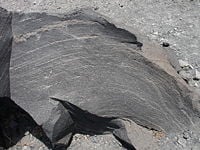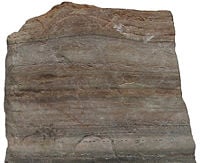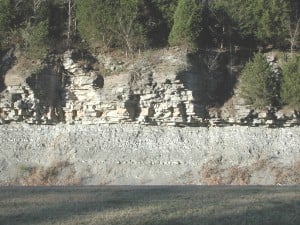Petrology
 From Nwe
From Nwe 
Petrology is a field of geology that focuses on the study of rocks and the conditions under which they are formed. It utilizes the classical fields of mineralogy, petrography,[1] and chemical analyses to describe the structure and composition of rocks. In addition, modern petrologists include the principles of geochemistry and geophysics to better understand the origins of rocks. There are three branches of petrology, corresponding to the three main types of rocks: igneous, metamorphic, and sedimentary.
The study of rocks provides us with important information about the nature of the Earth's crust and mantle. In addition, it enables us to gain a sense of the Earth's history, including tectonic processes that occurred over the long course of geological time. On a practical level, the field of petrology helps us gain an understanding of many of the raw materials we rely on for our sustenance and technological development.

Etymology
The word petrology is derived from a combination of the Greek words petra (πέτρα), meaning "rock," and logos (λόγος), meaning "knowledge."
Branches of petrology
- Igneous petrology focuses on the composition and texture of igneous rocks (rocks such as granite or basalt which have crystallized from molten rock or magma). Igneous rocks include volcanic and plutonic rocks.
- Sedimentary petrology focuses on the composition and texture of sedimentary rocks (rocks such as sandstone, shale, or limestone which consist of pieces or particles derived from other rocks or biological or chemical deposits, and are usually bound together in a matrix of finer material).
- Metamorphic petrology focuses on the composition and texture of metamorphic rocks (rocks such as slate, marble, gneiss, or schist which started out as sedimentary or igneous rocks but which have undergone chemical, mineralogical or textural changes due to extremes of pressure, temperature or both).
- Experimental petrology employs high-pressure, high-temperature apparatus to investigate the geochemistry and phase relations of natural or synthetic materials at elevated pressures and temperatures. Experiments are particularly useful for investigating rocks of the lower crust and upper mantle that rarely survive the journey to the surface in pristine condition. The work of experimental petrologists has laid a foundation on which modern understanding of igneous and metamorphic processes has been built.

Significance of studying rocks
The study of rocks is important for several reasons:
- Their minerals and global chemistry provide information about the composition of the Earth's crust and mantle.
- Their ages can be calculated by various methods of radiometric dating, and a time sequence of geological events can be put together.
- Their features are usually characteristic of a specific tectonic environment, allowing scientists to reconstitute tectonic processes.
- Many rocks host important ores that provide valuable raw materials that we rely on for our sustenance and technological development.
See also
- Igneous rock
- Metamorphic rock
- Mineral
- Rock (geology)
- Sedimentary rock
Notes
- ↑ "Petrography" is a branch of petrology involving the study of the mineral content and textural relationships within rocks. The term "lithology" was once roughly synonymous with petrography, but today lithology is essentially a subdivision of petrology focusing on macroscopic hand-sample or outcrop-scale description of rocks.
References
ISBN links support NWE through referral fees
- Best, Myron G. Igneous and Metamorphic Petrology. 2nd ed. Oxford, UK: Blackwell, 2003. ISBN 1405105887
- Blatt, Harvey, and Robert J. Tracy. Petrology: Igneous, Sedimentary, and Metamorphic. 2nd ed. New York: W.H. Freeman, 1995. ISBN 0716724383
- Pellant, Chris. Rocks and Minerals. Smithsonian Handbooks. New York: Dorling Kindersley, 2002. ISBN 0789491060
- Shaffer, Paul R., Herbert S. Zim, and Raymond Perlman. Rocks, Gems and Minerals. Rev. ed. New York: St. Martin's Press, 2001. ISBN 1582381321
- Skinner, Brian J., Stephen C. Porter, and Jeffrey Park. Dynamic Earth: An Introduction to Physical Geology. 5th ed. Hoboken, NJ: John Wiley, 2004. ISBN 0471152285
- Winter, John D. An Introduction to Igneous and Metamorphic Petrology. Upper Saddle River, NJ: Prentice Hall, 2001. ISBN 0132403420
Credits
New World Encyclopedia writers and editors rewrote and completed the Wikipedia article in accordance with New World Encyclopedia standards. This article abides by terms of the Creative Commons CC-by-sa 3.0 License (CC-by-sa), which may be used and disseminated with proper attribution. Credit is due under the terms of this license that can reference both the New World Encyclopedia contributors and the selfless volunteer contributors of the Wikimedia Foundation. To cite this article click here for a list of acceptable citing formats.The history of earlier contributions by wikipedians is accessible to researchers here:
- Petrology history
The history of this article since it was imported to New World Encyclopedia:
- History of "Petrology"
Note: Some restrictions may apply to use of individual images which are separately licensed.
↧ Download as ZWI file | Last modified: 02/04/2023 04:39:38 | 127 views
☰ Source: https://www.newworldencyclopedia.org/entry/Petrology | License: CC BY-SA 3.0
 ZWI signed:
ZWI signed: KSF
KSF